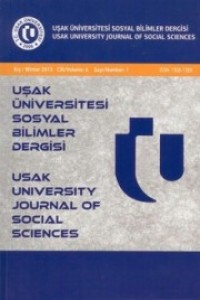Öz
Kaynakça
- Bean, J. C. and Peterson, D. (2003). Grading Classroom Participation. New Directions for Teaching and Learning, 74, 33-40.
- Böhlke, O. (2003). A Comparison of Student Participation Levels by Group Size and Language Stages During Chatroom and Face-to-Face Discussion in German. Calico Journal, 21/1, 67-87.
- Büyüköztürk, Ş. (2011). Sosyal Bilimler İçin Veri Analizi El Kitabı. Ankara: Pegem Akademi.
- Carrison, C. and Ernst-Slavit, G. (2005). From Silence To A Whisper To Active Participation: Using Literature Circles With ELL Students. Reading Horizons, 46/2, 93-113 .
- Critelli, A. and Tritapoe, B. (2010). Effective Questioning Techniques To Increase Class Participation. E-journal Of Student Research, 2/1, 1-7.
- Gardner, R., Heward, W. L., Grossi, T. A. (1994). Effects of Response Cards On Student Participation And Academic Achievement: A Systematic Replication With Inner-City Students During Whole-Class Science Instruction. Journal of Applied Behavior Analysis, 27/1, 63-71.
- Green, D. (2008). Class Participation In A Teacher Training College: What Is It and What Factors Influence It?, ELTED, 11/3, 15-26.
- Lee, P. (2005). Students’ Personality Type And Attitudes Toward Classroom Participation. Catesol State Conference, Los Angeles.
- Nickerson, S. (2005). Class Participation: Suggestions For Instroctor, 1-3.
- Ribot, E. J. (2011). Fostering Critical Thinking And Student Participation In Biological Sciences. Teaching Innovation Projects, 1/1, 1-8.
- Sariefe, S. and Klose, M. (2008). Students’ Attitude Toward Assessing In- Class Participation. Teaching and Learning, 1-9.
- Svinicki, D. M. (2005). Encouraging Student Participation In Class. Center For Teaching Effectiveness,1-2.
- Thompson, A. (2008). Daily Experts: A Technique to Encourage Student Participation. The Teaching Professor, 2-6.
- Wilen, W. W. (2004). Encouraging Reticent Students’ PArticipation in Classroom Discussion. Social Education, 1-8.
- Woods, R. D. (1996). Participating More Than Atteandace. Journal of Engineering Education, 177-181.
Öz
Recently, The New Curriculums are becoming more student centered by means of new concealing paradigms. Students are taking place more actively during the lesson. However, sometimes students tend not to participate the lesson during class time. The attitudes of studenst is quite important in this period. In this study, it is aimed to define the attitudes of the students’ participation during class time. The descriptive model is used. The sample of this study comprises 239 students chosen randomly among the secondary and high school students in Afyonkarahisar and in Bolvadin. In this study, the Likert scale consisting of 20 questions is used. The data acquired from students have been analyzed by t-test and one-tailed variance analysis to find out whether there is a statistical meaningful difference among the attitudes of students towards participating during class in terms of descriptive variables such as gender, class and school type.
Anahtar Kelimeler
Kaynakça
- Bean, J. C. and Peterson, D. (2003). Grading Classroom Participation. New Directions for Teaching and Learning, 74, 33-40.
- Böhlke, O. (2003). A Comparison of Student Participation Levels by Group Size and Language Stages During Chatroom and Face-to-Face Discussion in German. Calico Journal, 21/1, 67-87.
- Büyüköztürk, Ş. (2011). Sosyal Bilimler İçin Veri Analizi El Kitabı. Ankara: Pegem Akademi.
- Carrison, C. and Ernst-Slavit, G. (2005). From Silence To A Whisper To Active Participation: Using Literature Circles With ELL Students. Reading Horizons, 46/2, 93-113 .
- Critelli, A. and Tritapoe, B. (2010). Effective Questioning Techniques To Increase Class Participation. E-journal Of Student Research, 2/1, 1-7.
- Gardner, R., Heward, W. L., Grossi, T. A. (1994). Effects of Response Cards On Student Participation And Academic Achievement: A Systematic Replication With Inner-City Students During Whole-Class Science Instruction. Journal of Applied Behavior Analysis, 27/1, 63-71.
- Green, D. (2008). Class Participation In A Teacher Training College: What Is It and What Factors Influence It?, ELTED, 11/3, 15-26.
- Lee, P. (2005). Students’ Personality Type And Attitudes Toward Classroom Participation. Catesol State Conference, Los Angeles.
- Nickerson, S. (2005). Class Participation: Suggestions For Instroctor, 1-3.
- Ribot, E. J. (2011). Fostering Critical Thinking And Student Participation In Biological Sciences. Teaching Innovation Projects, 1/1, 1-8.
- Sariefe, S. and Klose, M. (2008). Students’ Attitude Toward Assessing In- Class Participation. Teaching and Learning, 1-9.
- Svinicki, D. M. (2005). Encouraging Student Participation In Class. Center For Teaching Effectiveness,1-2.
- Thompson, A. (2008). Daily Experts: A Technique to Encourage Student Participation. The Teaching Professor, 2-6.
- Wilen, W. W. (2004). Encouraging Reticent Students’ PArticipation in Classroom Discussion. Social Education, 1-8.
- Woods, R. D. (1996). Participating More Than Atteandace. Journal of Engineering Education, 177-181.
Ayrıntılar
| Bölüm | Makaleler |
|---|---|
| Yazarlar | |
| Yayımlanma Tarihi | 29 Temmuz 2016 |
| Yayımlandığı Sayı | Yıl 2016 Cilt: 9 Sayı: 27/3 |
Adres: Uşak Üniversitesi Sosyal Bilimler Enstitüsü
Telefon: 0276 221 21 60 Faks :0276 221 21 61
E-posta: sosyaldergi@usak.edu.tr


